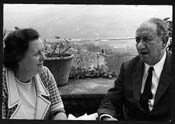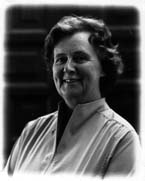This page contains a short biography of Eilís Dillon, followed by links to books featured in this website. The reviews at the bottom of the page compare her to writers as diverse as John Buchan{{not in the list}}, Graham Greene, Robert Louis Stevenson, Dorothy L. Sayers, Daphne du Maurier and Émile Zola. You can also link to a complete {{LINK}}chronological list of her published works.
Eilís Dillon, Irish writer
Eilís Dillon was born in Galway, in the West of Ireland, on 7 March 1920. Her father, Thomas Dillon, was Professor of Chemistry at University College Galway. Her mother, Geraldine Plunkett, was the sister of the poet Joseph Mary Plunkett, one of the seven signatories of the Proclamation of the Irish Republic, who was executed in Kilmainham Gaol at the end of the 1916 Easter Rising.

Eilís was educated at the Ursuline Convent in Sligo, and was sent to work in the hotel and catering business in Dublin. In 1940, at the age of 20, she married a 37-year-old Corkman. Her husband, Cormac Ó Cuilleanáin, became Professor of Irish at University College Cork. Eilís had always written poetry and stories, and in the intervals of bringing up three children and running a student hostel for the university, she developed her writing into a highly successful professional career. At first she wrote children’s books in Irish and English, then started to write novels and detective stories. Over twenty of her books were published by Faber and Faber, winning critical acclaim and a wide readership. Her work was translated into fourteen languages.
In the 1960s, her husband’s poor health prompted early retirement and a move to Rome. He died in 1970. Eilís Dillon’s large historical novel about the road to Irish independence in the 19th and early 20th centuries, Across the Bitter Sea, was published in 1973 by Hodder & Stoughton in London, and Simon & Schuster in New York. It became an instant bestseller.

In 1974 Eilís married Vivian Mercier, Professor of English in the University of Colorado at Boulder. They moved to California when Vivian was appointed to a chair in the University of California, Santa Barbara. They spent each winter in California until Vivian’s retirement in 1987, returning to Ireland for the spring and summer.
Eilís Dillon was active in a number of public and cultural bodies. She served on the Arts Council, the International Commission for English in the Liturgy, the Irish Writers’ Union and the Irish Writers’ Centre. She was a Fellow of the Royal Society of Literature, and a member of Aosdána, the State academy of writers, artists and composers. She had long argued for the establishment of such a body.
Vivian’s death in 1989 was followed by the death in 1990 of Eilís’s daughter Máire, who was a violinist with the London Philharmonic Orchestra. Despite these blows, and her own declining health, Eilís kept writing until the last months of her own life. An honorary doctorate was conferred on her by University College Cork in 1992. Her last two published works were Children of Bach (1993), a children’s novel set in Hungary at the time of the Holocaust, and her edition of Vivian Mercier’s posthumous Modern Irish Literature: Sources and Founders (Oxford, 1994). Her scholarly work on this book meant that her own last novel remained unfinished.
Eilís Dillon died on 19 July 1994. Of her fifty books, ten are now in print and others will shortly be republished. A special prize, the Eilís Dillon Award, is given each year as part of the Bisto Book Awards. She herself had won the main Bisto Book of the Year award in 1989 with The Island of Ghosts.
Reviewers’ Comments
Among the writers to whom Eilís Dillon was compared were John Buchan{{not in this list}}, Graham Greene, Robert Louis Stevenson, Dorothy L. Sayers, Daphne du Maurier and Émile Zola:
{{LINK these reviews to the relevant novel pages}}
“Her picture of academic life is the best we have read since Dorothy Sayers gave us ‘Gaudy Night’.” (Social and Personal)
“A quite remarkable novel … a huge panorama of suffering, frustration and biterness … one of the most compelling and convincing love stories I have read … a novel of which Zola might have been proud.” (The Sunday Times)
“The period and the passion are evoked effortlessly … similar in manner if not in subject to the historical novels of Daphne du Maurier” (Books)
” … as original and as full of apprehensive suspense as a Graham Greene entertainment for grown-ups.” (New Statesman)
“Of those I have read, the best, I think, is Eilís Dillon’s San Sebastian, which has a young hero whose lonely self-reliance would not disgrace R.L. Stevenson, and a fantastically imagined adventure excitingly told in an atmosphere that never loses the poetry of the ocean, washing the coast of Ireland.” (The Observer)
